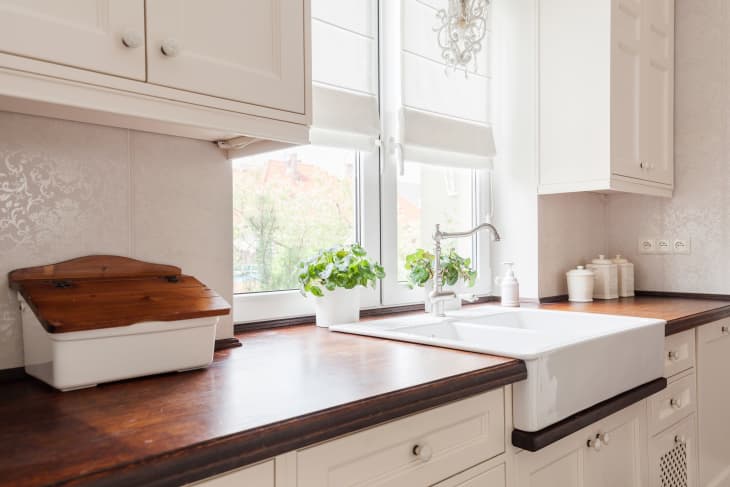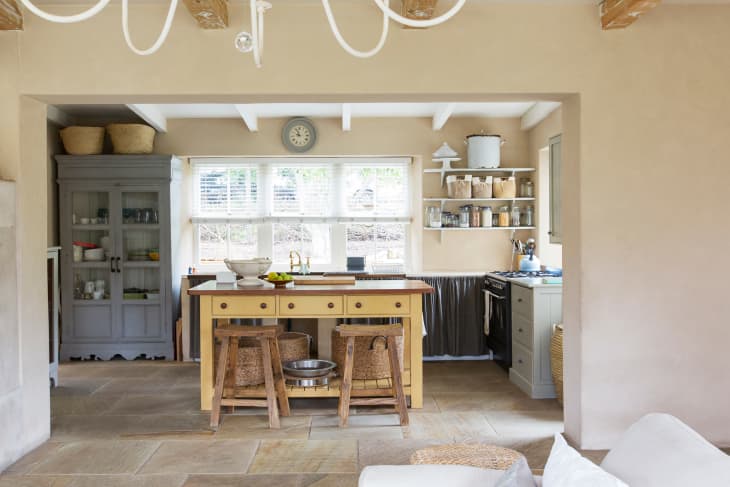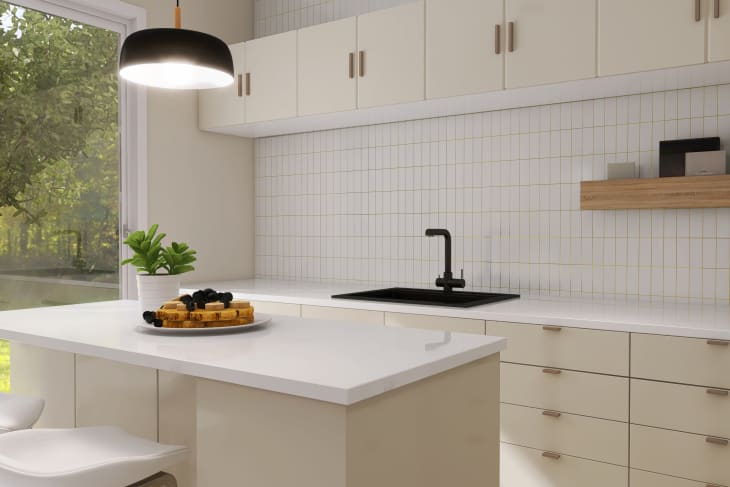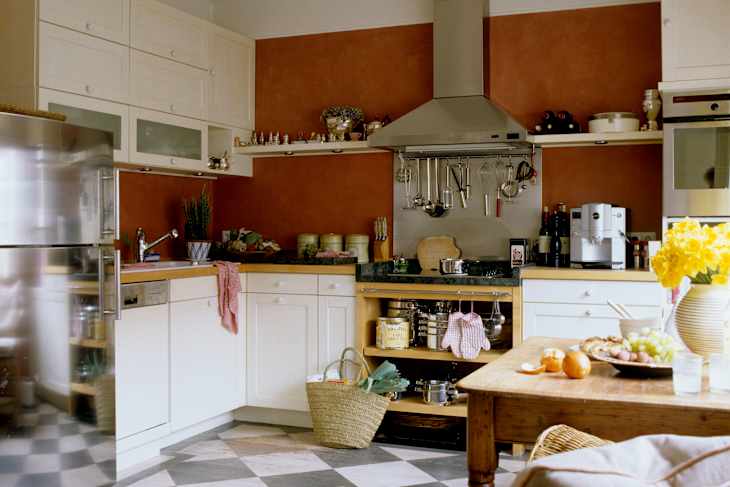

What makes a kitchen great in 2025? Less cookie-cutter, more personal and functional. Kitchen designs are moving away from a copy-and-paste approach and into an era where purpose is key — namely, how you want to use it to gather, to cook, and to connect. That personalized approach is finally opening the door to a lot of fun looks that break the mold — and I am so here for it.
I write this as I sit in my 1962 kitchen in all its pink wall oven, Formica counter, and original cabinet (painted a super-saturated green) glory. This kitchen is the opposite of a gut-job demo reno, because it was comfortable and functional as it was; I just wanted it to be a bit more … me. Which is where kitchen design is headed, according to the experts I chatted with. Here are three kitchen trends that designers say are finally fading, plus what’s taking their place.

Out: Farmhouse Overload
The farmhouse aesthetic probably won’t totally disappear anytime soon, but it’s definitely evolving. What happened? Honestly, it sounds like there’s just nothing new left here. “Designers and homeowners have almost exhausted the idea of bringing up a discussion about farmhouse trends and fresh ideas for this style,” says Peter Wells, senior principal designer at Amerock.
Instead: Curated Vintage Authenticity
But that doesn’t mean people don’t want character in the kitchen. They’re just finding it beyond shiplap.
“There’s this movement toward kitchens that look and feel like they’ve evolved over the last 100 years, not just installed yesterday,” Kelsey McGregor, founder of Kelsey Leigh Design Co., says. “Even in new construction, people are asking, ‘How do I make this feel like it’s always been here?’ There’s a desire to add history, soul, and texture to spaces that would otherwise feel too perfect or sterile.”
According to the 2025 U.S. Houzz Emerging Summer Trends Report, searches for “vintage kitchens” have doubled compared to last year, while china cabinets and hutches have triply surged as traditional storage makes a major comeback. This isn’t about a museum replica of a ’50s or ’60s kitchen — it’s about selecting the elements that add genuine character (hello, pink oven!).
Designer Kerri Pilchik has a few words of wisdom. “Everyone right now is obsessed with English kitchens, myself included, but make sure that you choose those design elements that work for you functionally,” she advises. “Islands that look like farm tables are beautiful, but think about how you will install electrical and plumbing.” In other words, just because it’s gorgeous doesn’t mean it makes sense.

Out: Monochromatic Kitchens
You’ve surely seen them — those pristine all-white, all-the-time kitchens that look like nothing has ever been cooked in them. “The overly matchy, all-one-tone kitchen — especially monochromatic looks where cabinetry, counters, and walls blend into a single flat tone — is starting to feel uninspired,” says Moses Brach, head of A&D partnerships at Fabuwood.
Instead: Personal Touches Through Color and Natural Materials
The replacement? Kitchens that look like, you know, someone’s home. Heather Shannon, senior vice president of marketing and communications at NKBA, sees this as part of a broader shift: “Designs are more and more personal and personalized.” Part of that? More color and more warmth. According to the Houzz trend report, “color drenching” searches are up four times over last year, while white oak kitchen cabinets have surged 46% year-over-year as part of the broader trend toward wood-heavy interiors.
McGregor notices this evolution in wood tones specifically. “What I’m seeing now is a shift toward wood tones that feel more grounded and aged,” she says. “We’re still using white oak, but the finishes are getting grayer, like Minwax’s ‘weathered oak’ [stain], which has just enough gray to lend a heritage feel. It knocks that brand-new look off the kitchen, which is what people are craving — something that feels like it’s been there a while.”
Nancy Dow of Sierra Living Concepts is going for bold color in her own home. “For my own kitchen renovation in process now, my cabinets will be army green and the countertops will be honed Carrara marble,” she says. “This has been a favorite color of mine for many years.” Which is key, she adds. “I do love the trend toward colorful cabinets rather than all white, but choose a color that you will love in 10 years.”
Additions that make a space look like a working kitchen are on the rise, too, with “pot racks and other actual cooking tools on display,” says Sarah Robertson of Studio Dearborn. She’s also seeing “more of a mix of materials again; tile, more subtle use of stone, and other materials for texture such as paneling, cabinetry, and metal hoods.”

Out: Impractical Storage and Technology
Pretty doesn’t always mean practical. Take appliance garages: brilliant in theory, frustrating in real life. “Full appliance garages are amazing but can sometimes be impractical for busy families who use small appliances like a blender, coffee maker, or rice cooker every day,” says Nureed Saeed of Nu Interiors. “Many of my clients have found that they leave the doors of the appliance garages open all day because the areas get so much use. This can be more unattractive and cumbersome than simply having things on the counter.”
The same goes for technology that’s more about novelty than utility. “Smart tech for the sake of being smart — more technology does not always equal better!” says Shannon. “The rapid speed of innovation has meant that in recent years, appliances and fixtures were hitting the market that had flashy capabilities but unrealistic uses.”
Instead: Functional Entertaining Zones
Instead of hiding everything away or adding unnecessary tech, designers are creating zones that reflect how people use their kitchens — including for connecting over coffee or cocktails. “I see more zoned planning in kitchens as the replacement,” explains Saeed. “So a coffee bar area, a morning prep area with a blender and coffee maker, and then another space for appliances for dinner prep.”
Shannon sees this as part of a broader wellness trend: “We’ve seen a push towards healthy living and wellness in how kitchens are designed; smoothie bars, beverage centers that don’t center alcohol, produce prepping stations.”
According to the Houzz report, “coffee bars” are up 19% over the previous year, while “dedicated whiskey bars” have nearly doubled, stating that this shows “desire for easy, accessible, and visually appealing drink setups, perfect for summer evenings with family and friends.” And the designers tend to agree!
What do you think about these kitchen design trends on their way out for 2025? Let us know in the comments below!